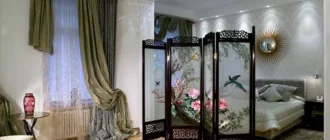
The creative heritage of the era of the “roaring twenties”
Jazz style in the interior is a design trend with a century of history, suitable for creating a comfortable and relaxed atmosphere. Most often it is found in public places – clubs, bars, theaters. Young people, creative personalities and fans of jazz music choose it to decorate their home. Jazz-style interiors will appeal to those who would like to sacrifice order and rigor in favor of freedom and bold combinations. Contrasts, ethnic elements and other unusual techniques help to make the atmosphere interesting and outstanding.
Jazz style in the interior tends to open spaces and a feeling of lightness, so it looks better in spacious rooms or studios without partitions. But even a small kitchen can be designed so that it looks like a cozy corner in a bar where your favorite music sounds.


The main characteristics and features of the jazz style in the interior
Jazz style helps to create an interior in which you want to relax and have fun with friends. It allows you to break the rules, experiment, combine elements from different directions. A classic leather sofa may well coexist with a zebra skin or Japanese engraving. Such eclecticism presents a wide scope for creativity. The main features of the jazz style in the interior include the following characteristics:
- Color spectrum. The decoration often uses a combination of black and white – for example, in a checkerboard tile on the floor or in a wallpaper pattern. Bright accents are also welcome: red, orange, turquoise, gold, bronze. However, the overall situation should be rather restrained. Calmness and balance are given to it by dark natural shades: wood, brick, stone or leather.
- Materials. The most popular types of flooring are wood or large tiles in dark shades. Commercial spaces often use concrete. Walls can be bare or painted brick and other textured materials. Wooden panels or wallpaper with geometric patterns are also suitable. Metal, glass and ceramics are often found in accessories.
- Furniture. Comfortable sofas with leather or velvet upholstery, but without an abundance of decorative pillows, fit perfectly into the jazz style. Instead of a cabinet with doors, it is better to choose open shelves. Furniture should be fairly simple, but solid and durable. Individual items can belong to different styles if they look harmoniously side by side. A common feature may be the material: most often it is dark wood and leather.
- Associations with music. Perhaps the most recognizable feature of jazz interiors are eloquent reminders of the corresponding musical style. A piano in the corner, a saxophone on the wall, dummies or stylized instruments are very common. It is not necessary to play them: you can simply enjoy the elegant forms, the beauty of wood, the reflections of metal. Decor is also used in the form of vinyl records or concert posters.
- Lighting. The main source of light is chandeliers and sconces with metal elements. They can be forged or decorated in an industrial style. Luminaires similar to those used in concert halls are suitable. In the evening, floor lamps help to create a cozy and sincere atmosphere. Another source of light can be a real or decorative brickwork fireplace.
- Textile. This style tends to be simple in general, but luxury elements are appropriate in the form of beautiful curtains with tassels or an expensive carpet. Sometimes an animal skin is placed on the floor. Otherwise, textiles are rarely used and do not attract attention. Bedspreads, pillows, furniture upholstery can be plain, discreet stripes or checks.
- Decor. A good idea for decoration is antique gizmos that you can buy in an antique shop. They usually fit easily into the setting, even if it’s a vintage bike or an advertising sign. Black and white photos are often placed on the walls: portraits of a family or famous jazz performers. A mirror in an interesting frame and other glare surfaces will be a suitable decor.


The history of jazz style in the interior
All jazz design has its roots in the period when the musical style that gave it its name was born. It happened at the turn of the XIX-XX centuries in the African-American neighborhoods of New Orleans. The cultural current was formed under the influence of blues, ragtime, a military band and West African ethnic motifs.
By the 1920s, which are called “roaring”, jazz rapidly gained popularity, first in America, and after it in Europe. The history of this style in the interior began in the optimistic era between the two world wars, when people traveled a lot, danced, were inspired by the achievements of scientific and technological progress and believed in a wonderful future.

Jazz became such a significant cultural phenomenon that it soon moved beyond the musical realm. At first, it was reflected in graphic design: new approaches were sought for the design of records, posters, thematic magazines and newspapers.
Then this style manifested itself in characteristic interiors: first in institutions where music was performed, and then in houses and apartments. It’s funny that this process was facilitated by the “dry law” in the United States. Despite the prohibitions, people wanted to have fun and organized private parties. For this, the atmosphere, reminiscent of a nightclub or a bar, was the best suited. The popularity of such parties with music and dancing was facilitated by the spread of radio.
Jazz style interior photo




















